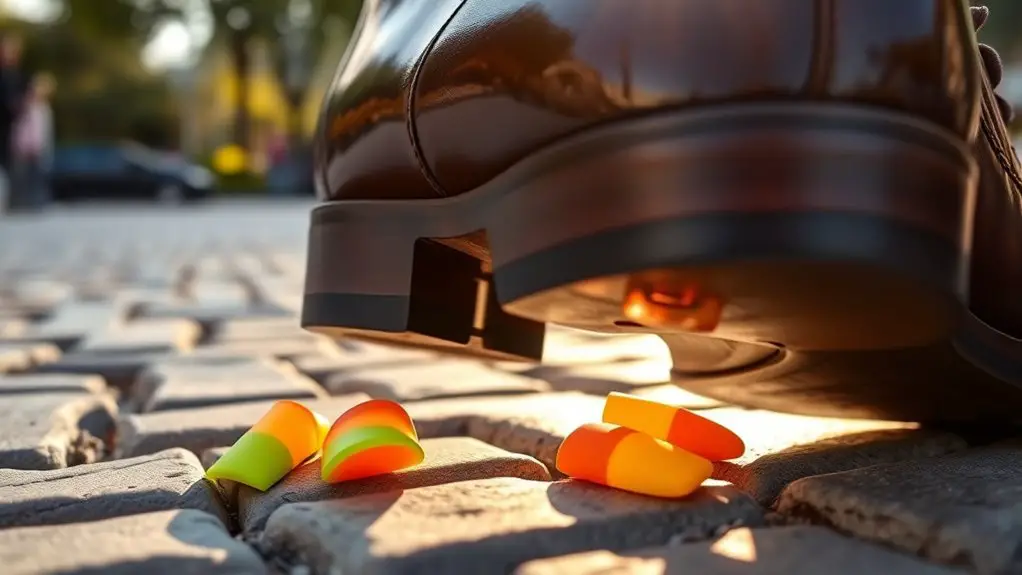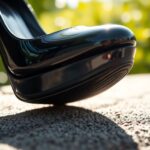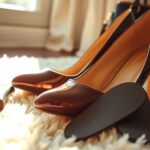To prevent heel slippage when walking, first make certain you choose the right shoe size and width, as a snug fit is essential. Opt for shoes with a better fit that support your foot shape, focusing on materials with grip. Using heel grips or cushions can fill gaps and enhance comfort. Adjust your lacing technique for a secure fit, and consider quality insoles for added support. Maintain your footwear regularly for peak performance, and discover more tips to enhance your walking experience.
Understand the Causes of Heel Slippage
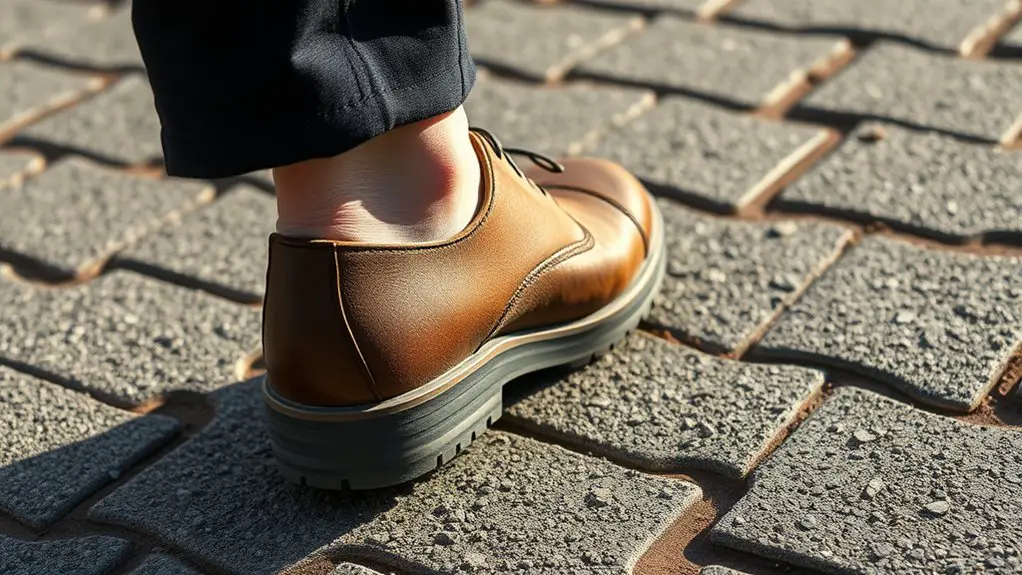
Understanding the causes of heel slippage is essential if you want to secure a comfortable fit in your shoes. One major factor lies in your foot anatomy; if your heel is narrower than the shoe’s heel cup, slippage is inevitable. Additionally, the shape and contour of your foot play a role in how well the shoe conforms to your structure.
Shoe design can also contribute to this issue. A poorly designed heel or inadequate cushioning can exacerbate movement within the shoe, leading to discomfort and instability. Materials that lack grip or flexibility can further increase slippage.
When selecting shoes, consider how the design accommodates your foot anatomy. Look for features like a snug heel counter and a molded footbed that cradles your heel. By understanding these causes, you can make informed choices to enhance stability and comfort, ultimately preventing heel slippage.
Choose the Right Shoe Size
To prevent heel slippage, it’s crucial to start with the right shoe size, which means measuring your feet accurately. Don’t forget that shoe width can greatly impact fit, so explore different width options to guarantee a snug fit around your heel. By prioritizing these factors, you’ll enhance comfort and stability in your footwear.
Measure Your Feet Accurately
Since choosing the right shoe size is essential for preventing heel slippage, measuring your feet accurately is the first step you should take. Start by standing on a piece of paper and tracing your foot to capture your foot measurements. Make certain you’re wearing the type of socks you plan to use with your shoes. Once you have the outline, measure the length from the heel to the longest toe. Don’t forget to measure both feet, as they can differ in size. Compare your measurements to the manufacturer’s sizing chart to find proper sizing. Remember, a snug fit is key; if you can slip your heel out easily, you may need to adjust your shoe size.
Consider Shoe Width Options
Many people overlook the importance of shoe width when selecting the right fit, but it plays a crucial role in preventing heel slippage. A shoe that’s too wide can cause your heel to lift, while a snug fit accommodates your foot shape effectively. Here are some considerations when choosing width options:
- Test various widths during a fitting.
- Choose shoe materials that provide some stretch while maintaining support.
- Pay attention to how the shoe conforms to your foot shape.
- Consider additional insoles or padding for better stability.
Opt for Shoes With a Better Fit
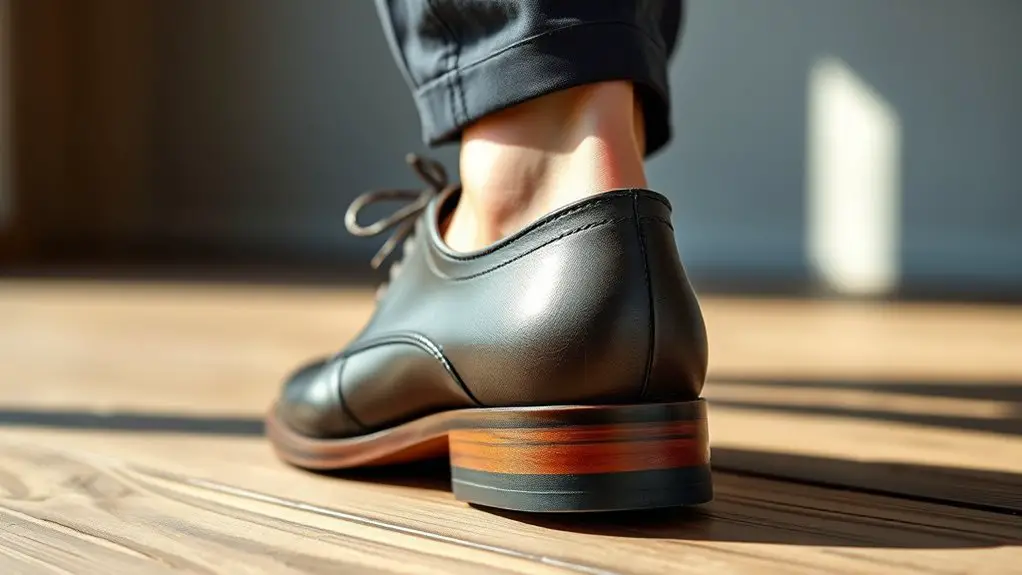
Finding the right fit in footwear is essential for preventing heel slippage. Start by understanding your foot anatomy; every foot has unique curves and widths that influence how shoes fit. Make sure you measure both length and width, as well as consider your arch type. Opt for shoe materials that offer flexibility and breathability, such as leather or mesh, which can conform better to your foot shape.
When trying on shoes, pay attention to how your heel sits in the back. There shouldn’t be excessive space that allows for movement. Take a few steps to assess comfort and stability—your heel should feel secure without pinching. Remember, shoes that are too loose can cause instability, while overly tight options can create discomfort. Investing time in finding shoes that fit well will not only prevent heel slippage but also enhance your overall walking experience.
Use Heel Grips or Cushions
If you’re struggling with heel slippage, using heel grips or cushions can make a significant difference. You’ll find various types available, from adhesive pads to silicone inserts, each designed to enhance comfort and stability. Applying them correctly guarantees they stay in place, providing the support you need for a secure fit.
Types of Heel Grips
When you’re dealing with heel slippage, choosing the right type of heel grip or cushion can make all the difference in comfort and stability. Here are some popular options to take into account:
- Silicone grips: These provide a soft, non-slip surface that molds to your heel, offering excellent cushioning and support.
- Foam pads: Lightweight and compressible, foam pads can fill gaps in your shoe, reducing slippage and adding comfort.
- Gel inserts: Combining silicone and foam, gel inserts deliver both shock absorption and stickiness for maximum grip.
- Fabric grips: These are designed to adhere to the shoe lining, providing a textured surface that keeps your heel secure.
Selecting the right type will guarantee you walk confidently without the frustration of constant adjustments.
Application Techniques Explained
To effectively apply heel grips or cushions, start by confirming your shoes are clean and dry, as any dirt or moisture can hinder adhesion. Next, remove the backing from the grip or cushion, exposing the adhesive side. Position it carefully at the back of the shoe’s heel area, making sure it aligns with your foot’s natural curve. Press firmly for a few seconds to secure it in place. For ideal heel slippage prevention, try your shoes on after application to check for comfort and fit. Walk around to verify the grips don’t shift or bunch up. This simple technique can greatly enhance your walking comfort, allowing you to enjoy your activities without worrying about slipping heels.
Adjust Your Lacing Technique
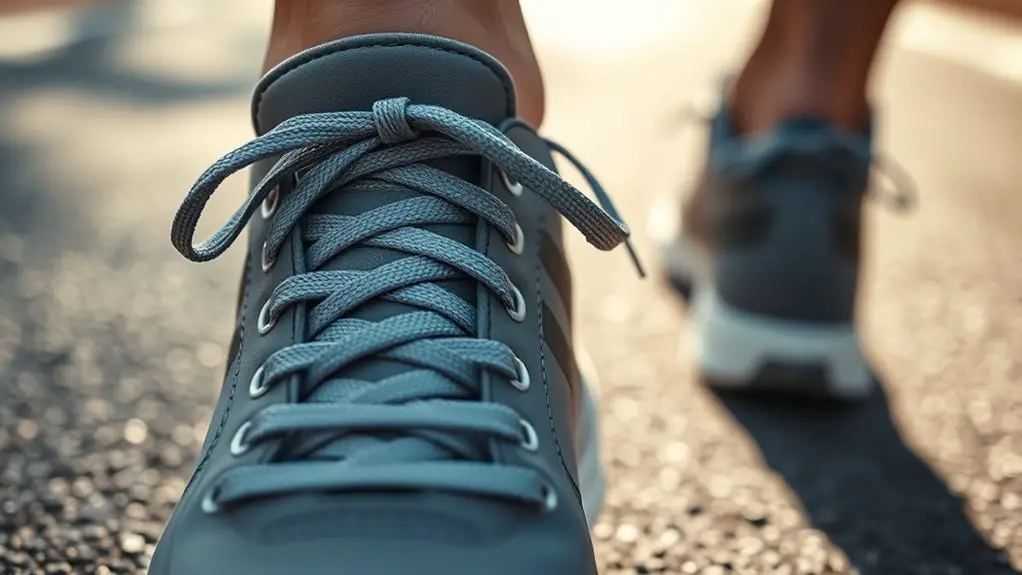
Adjusting your lacing technique can greatly enhance the fit of your shoes and reduce heel slippage. By experimenting with different lacing patterns and incorporating lace locking methods, you can secure your heel more effectively.
Enhancing your shoe fit is possible by adjusting lacing techniques to effectively reduce heel slippage.
Here are some techniques to contemplate:
- Heel Lock Lacing: Use the top two eyelets to create a locking effect that holds your heel in place.
- Skip Lacing: Skip eyelets to create a tighter fit around the midfoot, which can stabilize your heel.
- Criss-Cross Lacing: A classic method that allows for adjustable tightness; just be sure to pull the laces snugly.
- Lacing Tightness: Adjust the tension gradually from the bottom to the top to guarantee an even fit throughout.
Experimenting with these techniques can help you find the best configuration for your footwear, ultimately improving comfort and reducing heel slippage.
Consider Insole Options
If you’re struggling with heel slippage, considering your insole options can make a significant difference. The right insole materials can enhance your shoe’s fit and comfort, effectively reducing movement. Look for insoles made from high-density foam or gel, as they provide both cushioning and stability.
Additionally, ascertain your insoles offer adequate arch support tailored to your foot type. Proper arch support helps maintain foot alignment, which can minimize heel lift. You might also explore custom orthotics, especially if you have specific foot issues.
Don’t overlook the importance of a snug heel cup in your insoles; this feature can help lock your heel in place and prevent slippage. Experiment with different combinations of insoles and footwear to find the perfect fit. By thoughtfully selecting insoles, you’ll create a more secure and comfortable walking experience, effectively addressing those pesky heel slippages.
Maintain Your Footwear Regularly
Selecting the right insoles can greatly enhance your shoe’s fit, but maintaining your footwear regularly is just as important in preventing heel slippage. Proper shoe maintenance guarantees that your shoes continue to perform well and fit comfortably. Here are some essential tips for effective footwear care:
Choosing the right insoles is key, but regular shoe maintenance is crucial for optimal fit and comfort.
- Clean your shoes: Regularly remove dirt and debris to avoid wear and tear.
- Check for wear: Inspect the soles and linings for signs of damage that could affect fit.
- Store properly: Keep your shoes in a cool, dry place to prevent deformation.
- Use waterproofing sprays: Protect materials from moisture that can lead to deterioration.
Frequently Asked Questions
Can Heel Slippage Cause Blisters or Foot Pain?
Yes, heel slippage can definitely cause blisters and foot pain. To guarantee blister prevention and enhance foot comfort, choose well-fitted shoes and consider using insoles or heel grips to secure your feet properly during activities.
How Often Should I Replace My Shoes to Prevent Slippage?
You should replace your shoes every 300 to 500 miles, depending on their type and your usage. Monitoring the shoe lifespan helps guarantee ideal support and comfort, reducing the risk of slippage and foot issues.
Are Certain Shoe Brands Better for Preventing Heel Slippage?
When considering shoe brands, look for features like cushioned collars and adjustable lacing systems. Brand comparisons reveal that some prioritize fit and stability, which can greatly reduce heel slippage, enhancing your overall comfort while walking.
Can Orthotics Help With Heel Slippage Issues?
While some shoes fit snugly, others may leave you slipping. Orthotics can provide essential foot support, enhancing comfort and stability, which can greatly reduce heel slippage issues and improve your overall walking experience.
What Activities Are More Likely to Cause Heel Slippage?
Heel slippage often occurs during activities like running or brisk walking, especially on uneven or slippery walking surfaces. Poorly fitting running shoes exacerbate the issue, leading to discomfort and potential injuries over time.

